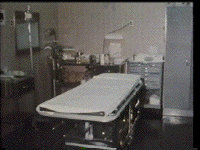
Parkland’s ‘Surgery Pit’ was divided into three separate hallways, each hall had an assigned RN and each hallway wound up connecting to one long corridor that we unimaginatively named "Front Hall". Front Hall was where it all happened. Two Unit Clerks (secretaries) ran the show along with the assistance of the Pit Boss, assigned RN's and everybody else.
I learned early on that Parkland's Unit Clerks could make you or break you and it was in your (and your patient's) best interest if you communicated clearly and respectfully with them. The amount of information that they processed simultaneously was awe-inspiring and they 'set the tone' for your shift. Unit clerks were responsible for tracking down doctors, nurses, interns, respiratory therapists, housekeeping and who-knows-else all while having to answer the telephones that rang incessantly, patient call lights, placing "stat" Dr's orders, dealing with irate, drunk or stoned patients and/or family members, calling radiology, lab, blood bank ...and the list goes on. Only the best Unit Clerks worked Surgery Pit.
Surgery ER Orientation:
- Trauma Hall: Had about nine fully equipped trauma rooms - one of which was outfitted for both pediatric and adult trauma. At the end of Trauma Hall, a door would lead to the Helipad. The patients who were triaged to Trauma Hall were in critical condition or had a very high likelihood of deteriorating rapidly. Many of our patients were in Trauma Hall as the result of Motor Vehicle Crashes, Penetrating Trauma (Stab, Gunshot wounds) and Burns. Trauma 1 was a room reserved for only the worst case scenarios. It was where John F. Kennedy was cared for.
- B Hall: About 10 rooms designated for high acuity surgical cases
- C Hall: About 10 rooms for low acuity surgical cases
[my room numbers may be 'off'' ... as my memory can be 'fuzzy'] - Front Hall: Unofficial stretcher spaces along the front corridor of Surgery. Usually reserved for 'stable' people who had been stabbed in the chest (and the like) and were scheduled to have repeated chest xrays in six hours. If their condition had not worsened - they would be discharged. Parking these patients in the hall would "free up" exam rooms for others.

One night when we were running full tilt. I was the assigned “Trauma Hall" nurse. And then, "The Bus Let Out” (a familiar phrase used when we suddenly got an onslaught of patients). Our trauma rooms were filled simultaneously.
Fatigue-wearing. healthy-looking people showed up looking like they were ready to work in the trauma rooms, I took advantage of their presence...“splint this, apply pressure here, draw a ‘crit’for me, watch this guy, take vital signs, bag him…” They understood my language and seemed to know what to do. It wasn’t until around 4 am that I thought to ask one of them, “So, who are you guys anyway?” They were medics in training with The National Guard.
My last night shift in Surgery ER was like any other. Sick and injured people. A lot of them. Counting was just not done - no time - our mission was to keep our heads above water, stay alert for any clinical changes in our patients' condition and to be prepared for what might hit the door next.
He was a tall African American man in dark clothing and in obvious distress - pale, leaning forward, clutching his abdomen, his staggered gait forebode impending collapse - an acute abdomen, to be sure. Swinging out of C-Hall, I spotted this man who apparently knew exactly where he needed to be - as he had bypassed triage and security to present himself to our Surgery Pit.
"Sir! How long have you been in pain???" I hollered out as I rushed towards him in order to get him on the nearest stretcher. His response was somewhat terse... "Ever since I got shot!".
Ahhh. Parkland.
Parkland 8: OB-Gyn






No Comments Yet, Leave Yours!
Proc (Bayl Univ Med Cent). 2005 Oct; 18(4): 412–414.
doi: 10.1080/08998280.2005.11928106
PMCID: PMC1255956
PMID: 16252037
Tributes to Dale Coln, MD, upon his retirement
Dale Coln, MD
Excerpt:
As director of pediatric surgery at Parkland Memorial Hospital, Dr. Coln took care of many children with a variety of injuries. He saw the need for a pediatric trauma unit. With the support of Parkland administration and funding from the Crystal Charity Ball, a pediatric trauma unit was opened in 1984. The influx of injured children came rapidly from the North Texas area to the only freestanding pediatric trauma unit in the country. This consolidated pediatric care of both indigent and private patients at Children's Medical Center and led to the unit's American College of Surgeons Level I designation in 2005. The unit now treats 3000 patients a year.
In addition to the large trauma service, he, Dr. Jack Chang, and Dr. Walter Andrews cared for the large number of newborns needing surgery at Parkland Memorial Hospital. Dr. Andrews and Dr. Chang were instrumental in starting the pediatric liver transplant service at Children's Medical Center.
Post a Comment